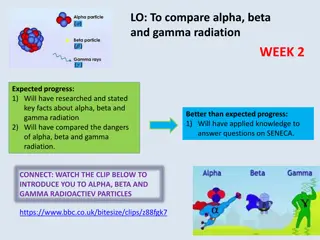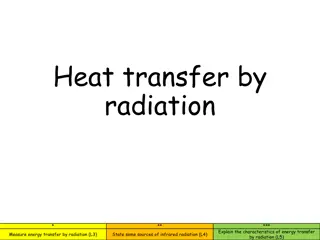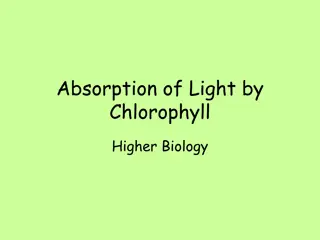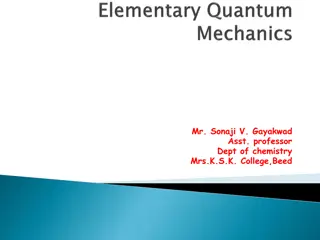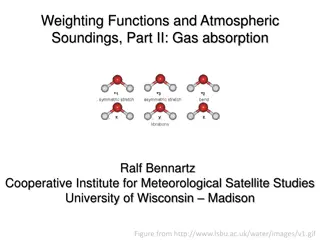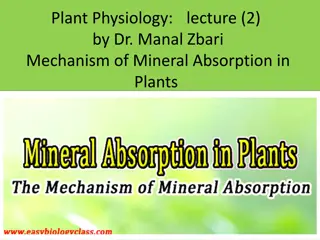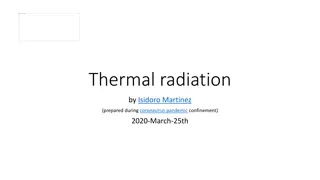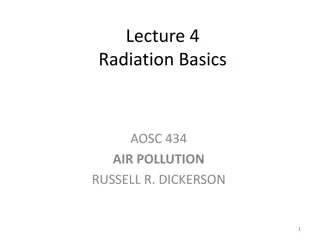Understanding Climate Change: Radiation Balance and Absorption of Light
This content delves into the complexities of Earth's radiation balance in the context of climate change. It discusses the effects of greenhouse gases, Earth's radiation balance, absorption of light, and factors influencing energy exchange. The text sheds light on the critical role of albedo, blackbody emitters, and the greenhouse effect in shaping our planet's climate dynamics.
Uploaded on Sep 10, 2024 | 3 Views
Download Presentation

Please find below an Image/Link to download the presentation.
The content on the website is provided AS IS for your information and personal use only. It may not be sold, licensed, or shared on other websites without obtaining consent from the author. Download presentation by click this link. If you encounter any issues during the download, it is possible that the publisher has removed the file from their server.
E N D
Presentation Transcript
Announcements I HW Set 3 Posted on My C253 Website (just 3.1 so far) No Group Assignment This Week Next Week s Group Assignment on Climate Change Today s Lecture (Climate Change Ch. 5) Next Lecture on Alternative Fuels
Climate Change - Overview A. Earth s Radiation Balance B. Effect of Greenhouse Gases C. Other Sources of Climate Change D. Temperature Record and Expected Future
Climate Change - Radiation Balance For a planet with a constant temperature, energy in = energy out (FS= FL) Energy in = light from sun (short wave = FS) Energy out = light from earth (long wave = FL) Energy of light reaching and leaving a given location on earth is not constant Light energy reaching earth goes from ~0 (night for half of earth) to S0(= 1370 W m-2= solar constant = equator at noon on equinox) From Seinfeld and Pandis (1998)
Climate Change - Radiation Balance To be balanced, REarth2S0 = 4 REarth2SE or SE = S0/4 (assuming all light reaching earth stays in earth) This is further complicated by light reaching earth being reflected back to space (clouds, sand, and snow are whiter than lava, oceans and forests) The fraction of incoming light reflected = albedo ~ 0.3 for the whole earth (now FS = (1 A) REarth2S0) with A = albedo From Seinfeld and Pandis (1998)
Climate Change - Radiation Balance - Blackbodies Both the sun and the earth are imperfect blackbody emitters where the energy emitted and wavelength of light depend on temperature Emitted light reaches a max at: max (in m) = 2897/T Based on temperatures of the Sun s surface and the Earth s surface, max(sun) ~ 0.6 m and (Earth) ~ 10 m Note: actual max observed from above earth is for light emitted from atmosphere From Baird and Cann, 2012
Climate Change - Radiation Balance Absorption of Light Besides solar light being absorbed at the surface or reflected, some light is absorbed in the atmosphere While atmospheric absorption of solar light is small (~20% of incoming flux), a much larger fraction of light leaving the Earth absorbs light (in the infrared region) Absorption of light emitted by Earth is basis of greenhouse effect From Baird and Cann, 2012 Seinfeld and Pandis, 1998
Climate Change - Radiation Balance Emission of light from the Earth depends strongly on temperature: FL = kT4 where k = Stephan-Boltzmann constant (= 5.6 x 10-8 W m-2 K-4) Thus, about 2X more light is emitted from the tropics (e.g. T ~ 300 K) than polar regions (T ~ 250 K) The most prevalent gas molecules (N2, O2, and Ar) are incapable of absorbing IR light (only heteroatom diatomic molecules can absorb light) However, other trace gases (CO2, H2O, CH4) can and do absorb efficiently in the IR region. This and IR emission from the upper atmosphere (which is cooler) reduce the earth s emission flux and heat the earth
Climate Change - Radiation Balance Averaged Energy Balance As greenhouse gases increase, the fraction of surface emitted energy leaving earth (235/390 in figure) decreases However, incoming (342 107) and outgoing energy (235) must remain balanced As a result, increased temperature (greenhouse warming) and surface emitted energy (390) are required Baird and Cann (text)
Climate Change - Radiation Balance Climate can be affected by the following changes: - changes to So (solar strength) - changes to A (albedo) - changes to absorption of outgoing radiation (greenhouse effect) - changes to feedbacks or sensitivity (change in temperature per change in energy forcing)
Climate Change - Radiation Balance - Questions Given that distance between Mars and the sun is 50% greater than the distance between the Earth and the sun and that the solar constant proportional to the inverse square of the distance, calculate the average temperature of Mars assuming an albedo of 0 and of 0.2. Is the assumption of an average temperature (above) reasonable? Why would an isothermal atmosphere (one where temperature is constant with height) result in greater IR losses? If water is a strong greenhouse gas, would we expect that regions of high humidity are generally warmer than regions of low humidity (all other conditions equal)? Why might this not be the case?
Climate Change - Greenhouse Gases To be an effective greenhouse gas, a molecule must: - absorb light in the infrared region (must have dipole moment for vibration mode) - 3 modes of vibration for CO2 shown O=C=O O=C=O O=C=O Symmetric vibration not allowed
Climate Change - Greenhouse Gases Molecules must absorb light in the right regions - roughly 7 to 25 m region - however, in some regions (5 to 7 and 13 to 17 m), essential no light from surface makes it to space due to current gases present - for this reason, CO2 is less effective as a greenhouse gas (at least for additional CO2)
Climate Change - Greenhouse Gases Spectral Saturation: see how going from 1 to 10 leads to close to a 10X increase in area vs. going from 10 to 50 From Wallace and Hobbs, 1977
Climate Change - Greenhouse Gases Molecules absorbing light in the IR window regions are more effective Additional CO2 is not as effective as additional N2O (absorbs at 7.5 to 9 m) on a forcing per ppm basis From Girard (old text)
Climate Change - Greenhouse Gases H2O as a greenhouse gas - the molecule responsible for the most greenhouse effect heating - the third most prevalent molecule in the atmosphere (on average, but composition is variable) - direct anthropogenic sources are insignificant (at least outside of deserts and the stratosphere) - also responsible for cooling through increasing albedo (in clouds) so normally kept separate from other greenhouse gases - water vapor is important indirectly as planet heating increases water vapor (this is covered under feedbacks)
Climate Change - Greenhouse Gases % Gas Mixing Change Lifetime Relative Ratio units per year years 10 to 200 Efficiency CO2 400 ppm 0.4 1 CH4 1800 ppb variable 12 23 N2O 323 ppb 0.2 120 206 CFC-11 0.26* ppb -0.52* 45 4600 Data from Baird and Cann + other sources * non-current source
Climate Change - Greenhouse Gases Carbon Dioxide - anthropogenic sources: - combustion of fossil fuels (long term problem) - deforestation (short term problem) - cement production (CaCO3 CaO + CO2(g)) (short term problem) - carbon dioxide sinks - uptake by plants and by surface layer of ocean (short- term storage) - uptake to sediments or minerals (long-term storage)
Climate Change - Greenhouse Gases CO2 Concentrations (from Baird and Cann text)
Climate Change - Greenhouse Gases Methane Natural sources: termites, swamps, animal emissions Anthropogenic sources: natural gas production/distribution changes in agricultural practices Sinks: reaction with OH radical transport to stratosphere Indirect Effects: stratospheric water, OH and O3 concentration changes
Climate Change - Greenhouse Gases METHANE Pre-industrial concentration of ~750 ppb Was increasing rapidly (~3%/year) until 1990s Rate slowed to no change, but has started to rise again
Climate Change - Greenhouse Gases Chlorofluorocarbons - Strong greenhouse gases - Have long lifetimes - Only anthropogenic sources - Indirect effects (loss of stratospheric ozone offsets some of the warming)
Climate Change Summary of Effects Greenhouse Gases From IPCC Fifth Assessment Report (2014)
Climate Change - Some Questions cont. Why are CH4 and N2O more effective greenhouse gases than CO2? If OCS were found to have significant anthropogenic emissions, what would you want to know about it before assessing if it could be a greenhouse gas? CO is not a very effective greenhouse gas, but it can affect two other greenhouse gases. What gases does it affect indirectly and why? 1. 2. 3.
Climate Change - Other Effects on Climate Categories Tropospheric Ozone (non-well mixed greenhouse gas) Stratospheric Ozone (loss causes cooling) Land Use Changes (affects uptake of CO2 and albedo) Light Scattering Aerosol Light Absorbing Aerosol Indirect Effects of Aerosol
Climate Change - Other Effects on Climate Tropospheric Ozone Anthropogenic emissions have lead to increase Increases are heterogeneous, plus hard to determine pre-industrial concentrations Stratospheric Ozone Loss in Stratosphere leads to cooling (more loss of energy out to space) However, loss of stratospheric ozone also leads to greater UV absorption (and heating) in troposphere As ozone loss is reversed, some heating may occur
Climate Change - Other Effects on Climate Aerosol Effects Light Scattering Aerosol As was discussed previously in visibility, aerosol particles of diameter 0.2 to 1 m is very efficient in scattering light A significant fraction is scattered in the backwards direction, so this effectively increases planetary albedo Increase in albedo leads to cooling Notice how smoke from Star fire is whiter vs. forest background
Climate Change - Other Effects on Climate Aerosol Effects Light Absorption Most aerosol constituents do not absorb significantly in the visible region (where light is most prevalent) A big exception is soot (elemental carbon emitted in inefficient combustion) Soot clouds lead to atmospheric warming (even if cooling the surface over short-term) Notice how smoke from Kuwait oil fires is black vs. desert background http://www.lpi.usra.edu/publications/slidesets /humanimprints/slide_16.html
Climate Change - Other Effects on Climate Indirect Effect of Aerosols One type is through modification of cloud reflectivity Polluted Case: more but smaller droplets Clean Case: fewer but larger droplets
Climate Change - Other Effects on Climate Indirect Effect of Aerosols Larger droplets reflect light more poorly per g of cloud water Polluted clouds look whiter from space Ship tracks are indicative of localized pollution Most apparent where: clouds are normally clean and with thin clouds (thick clouds have high albedos regardless) Source: http//www-das.uwyo.edu/~geerts/cwx/notes/chap08/contrail.html
Climate Change -Net Effect of Aerosol Particles For a while, it was thought aerosol effects were close to equal (but opposite in sign) as greenhouse gas effects Significance of aerosols has decreased (as well as an increase in significance of soot including deposition on snow) Other issue is residence time (short for aerosols and ozone, long for greenhouse gases) Reducing pollution would lead to an increase in warming in the short term
Climate Change - More Questions Do all aerosol particles lead to atmospheric cooling? The greenhouse effect from long-lived species will be nearly uniform around the globe, but what about effects from ozone and from aerosol particles? Increased soil dust emissions (e.g. from overgrazing in desert regions) should cause cooling. What minimizes this effect vs. emission of particles from sulfur emissions or from biomass combustion? 1. 2. 3.
Climate Change - Temperature Record and Expected Future How do we go from W m-2 flux change to T? Simple way is through Flux dependence on T However, this ignores some feedbacks which make climate less stable Example is increased T increases water vapor which increases net greenhouse effect A doubling of the W m-2 flux to T ratio is expected because of feedbacks Sensitivity is a measure of T expected to change in CO2 concentration (or equivalent greenhouse gases) and is not well known (even though flux change is well predicted)
Climate Change - Temperature Record and Expected Future Temperature record (looking at T vs. climate mean) shows strongest increase from about 1975 Short-term variability affects record (due to El Ni os and volcanic eruptions) Foster and Rahmstorf, Environ. Res. Lett, 2011 Shows removal of variability due to El Ni o, solar variability, and volcanic eruptions From IPCC Fifth Assessment Report (2014)
Climate Change - Temperature Record and the Future Changes Besides Mean Air Temperatures Greater warming observed at higher latitudes Decrease in diurnal and annual temperature changes Loss of sea ice (in Arctic with slight increase in Antarctic) and glaciers Increase in sea-level (from expansion of water and decrease of glacial ice) Changes to hydrology (more rain, less snow, greater evaporation)
Climate Change Some more questions 1. Which temperatures are rising faster, daytime or nighttime temperature? Why would an increase in precipitation be expected? List two consequences of global warming besides changes in temperature? 2. 3.








